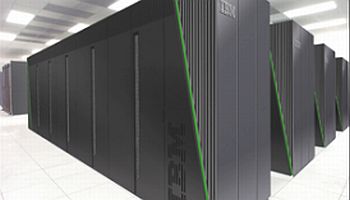IBM Blue Gene Supercomputer Grabs Green Title

IBM’s Blue Gene/Q has topped the Green500 list as the most energy-efficient supercomputer
According to Green500.org, IBM supercomputers are the most energy-efficient in the world.
In fact, the latest Supercomputing ‘Green500 List’ announced by Green500.org shows that a prototype of IBM’s next-generation Blue Gene/Q supercomputer is number one on the list.
The Green500 provides rankings of the most energy-efficient supercomputers in the world. The organisation raises awareness about power consumption, promotes alternative total cost of ownership performance metrics, and works to ensure that supercomputers only simulate climate change and not create it. The Green500 list has three releases per year: November, February and June.
IBM’s Green Power Is In The Genes
 The latest list shows that six of the top 10 most energy-efficient supercomputers in the world are built on IBM high-performance computing technology, IBM said. The list includes supercomputers from China to Germany and the United States that are used for a variety of applications such as astronomy, climate prediction and life sciences. IBM also holds over half the top 100 positions on this list, IBM said.
The latest list shows that six of the top 10 most energy-efficient supercomputers in the world are built on IBM high-performance computing technology, IBM said. The list includes supercomputers from China to Germany and the United States that are used for a variety of applications such as astronomy, climate prediction and life sciences. IBM also holds over half the top 100 positions on this list, IBM said.
Energy efficiency, including performance per Watt for the most computationally demanding workloads, has long been a core design principle in developing IBM systems, according to IBM officials. Energy-efficient supercomputers can allow IBM clients to realise critical cost savings by lowering power consumption and reducing expenses associated with cooling. For example, for every US dollar spent on electricity with the largest petascale system on the Green500 list, clients would spend less than 40 cents on a system based on IBM Blue Gene/Q and would be 2.5 times more energy-efficient, IBM said in a press release.
IBM Blue Gene/Q is scheduled to be deployed in 2012 by two of the US Department of Energy’s national laboratories, Lawrence Livermore National Laboratory and Argonne National Laboratory, both of which collaborated closely with IBM on the design of Blue Gene, influencing many aspects of the system’s software and hardware, IBM said.
Meanwhile, the University of Edinburgh and Columbia University contributed to Blue Gene/Q’s processor chip design. Both institutions plan to use the system to advance QCD (quantum chromodynamics), which is a part of the study of particle physics.
For its part, IBM offers the broadest range of supercomputers represented on the Green500 List, including Blue Gene, Power servers, System x iDataPlex, BladeCentre and hybrid clusters, IBM said.
Top Of The Graphs
An IBM supercomputer is also top of the Graph500 list, IBM said. Backed by a steering committee of over 30 international HPC experts from academia, industry and national laboratories, the Graph 500 is a set of large-scale benchmarks for data-intensive applications – an important metric as information increases exponentially.
Argonne National Lab’s Blue Gene/P supercomputer “Intrepid” is number one on the list after analysing the largest graph ever on a parallel machine. Graph algorithms are a core part of many analytics workloads. The Blue Gene/P-based “Jugene” supercomputer at the Juelich Supercomputing Centre is top of the Graph500 charts.
SWift Adaptive Runtime Machine
In related news, ETI (ET International), a provider of system software solutions for hybrid and many-core hardware architectures, announced that it helped achieve four spots on the June 2011 Graph 500 List, including three in the top 10 and one with the second-highest performance per core, as unveiled at the ISC11 show in Hamburg, Germany. Supercomputers using ETI’s SWARM (SWift Adaptive Runtime Machine) runtime environment came in at numbers six, eight and nine for their performance on the Graph 500 benchmark, ETI officials said.
ETI’s SWARM delivered the best multi-node results for every scale problem to which it was submitted, ETI said. Specifically, when running SWARM, the Texas Advanced Computing Center’s Lonestar 4 came in at number six. At 512 nodes, Lonestar delivered 8.1 giga-edges per second (GE/s). In the eighth spot, SWARM’s performance on Sandia National Lab’s Red Sky at 512 nodes delivered 9.5 GE/s, almost double the speed of MPI on the same machine.
At 256 nodes, Intel’s Endeavor was ninth on the list when running SWARM, at 6.9 GE/s, an incredible 11-fold improvement over MPI. Also using SWARM, Intel’s Discovery placed 26th on the list at a single node, and was one of three special mentions for its achievement of the second-highest performance per core at 17.625 million traversed edges per second per core.
“These systems’ performance on the Graph 500 is a validation of the power of ETI’s technology to allow programmers to realize the capacity of advanced many-core computing systems,” Rishi Khan, vice president of research and development at ETI, said in a statement.
“SWARM’s impressive results underscore how critical it is to put the right runtime environment in place in order to exploit the parallelism of advanced machines” he wrote. “The Graph 500 benchmark is one we take very seriously as an effective measure of a computer’s ability to efficiently solve the more advanced, data-driven problems that are so pervasive in today’s applications.”
ETI officials said the company’s SWARM runtime environment was developed specifically to address the performance challenges presented by the intersection of massively parallel software applications and hybrid many-core computing systems. The software enables easy and efficient programmability of applications for many-core computing systems, and is one of many components of ETI’s system services, including benchmarking, hardware and software design, performance-critical programming and consulting, the company said.